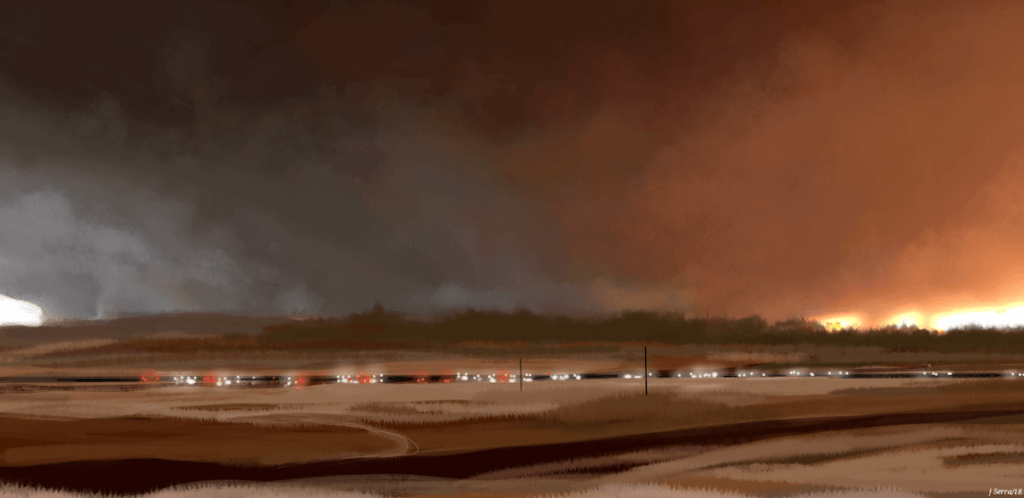
By Pau Costa Foundation and CERTEC-UPC teams, organizers of the Forum on Catalan Wildfire Research, including Nuria Prat-Guitart, Sebastien Lahaye, Oriol Vilalta, Mariona Borras, Jordi Vendrell, Celia Conde, Helena Ballart, Guillem Canaleta (Pau Costa Foundation) and Mario M. Valero, Elsa Pastor (CERTEC-UPC)
The wildfire forecast for 2019 projected a very challenging year in the Western Mediterranean of Europe for various reasons – from fuel to people to climate. First, fuel loads are greater than ever seen before, due to the rural abandonment and depopulation resulting from the decline of rural economies that in the past had effectively fixed people in the territory. Second, a densely populated Mediterranean region, with an increasing number of citizens living in the wildland-urban interface (WUI) who are unaware of the risk and without proper wildfire protection measures. And third, the increasing risk of wildfires resulting from climate change. During the first half of 2019, severe droughts and heat waves have affected the region, increasing stress on dense and volatile vegetation and expanding the fire season.
These factors led, in June 2019 alone, to five large wildfires that burned over 13,000 ha (32,000 acres) [1] in Spain. The first of them, the Ribera d’Ebre Wildfire (also known as La Torre de l’Espanyol Wildfire), which started on June 26, affected 6,500 ha (16,000 acres) in Catalonia, in the northeast region of Spain. This fire consumed the first 3,600 ha (8,900 acres) in only a few hours and burned for five days. Extreme winds caused the fire to spread rapidly through forest, abandoned agricultural lands and shrubs; 51 evacuations were required and rapid deployment of fire suppression operations that came from across the country to help. These efforts prevented the fire from spreading over a forest massif of 20,000 ha (50,000 acres), in part because the few healthy agricultural lands modified the fire spread and facilitated fire suppression.
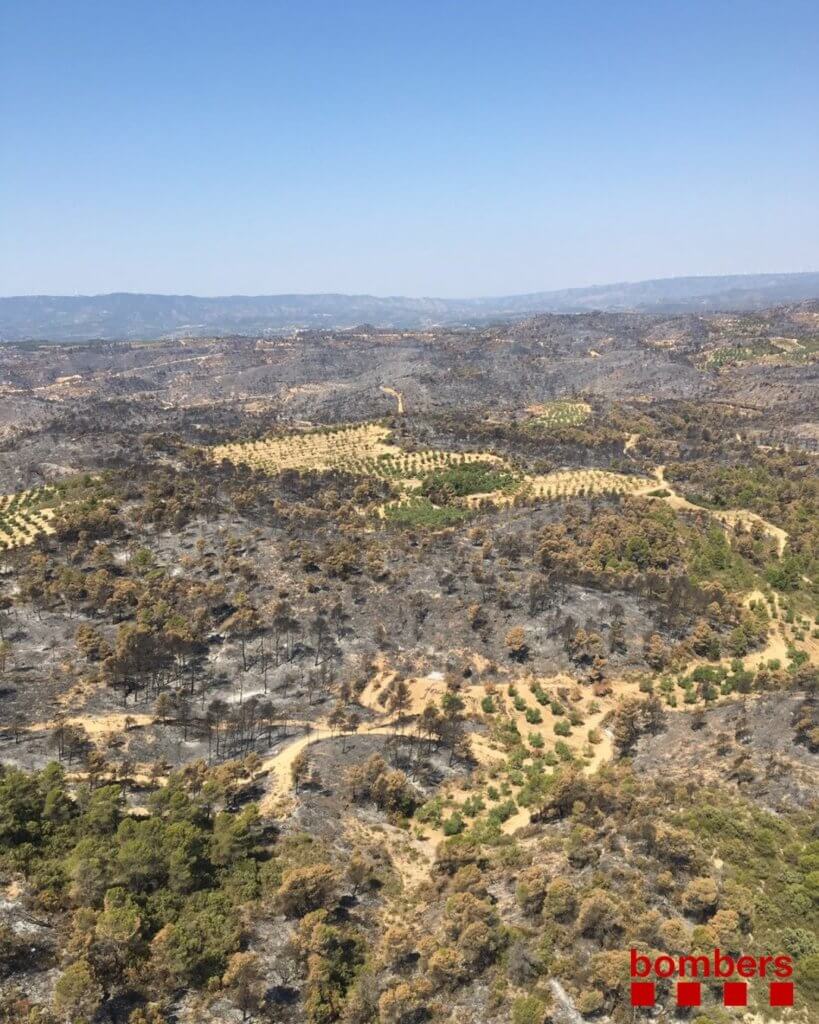
#2 CAPTION
Ribera d’Ebre Wildfire, June 2009. Source: Catalan Fire and Rescue Service.
The 2019 fire season is not over, and fires such as the Ribera d’Ebre Wildfire highlight the need to coordinate efforts from all local and regional actors who can make a difference in the different stages of the emergency management cycle, with special emphasis on prevention, preparedness, response and mitigation.
With these challenges in mind, we share the guiding framework and outcomes of the Forum on Catalan Wildfire Research that took place in November 2018, at the Diagonal-Besòs Campus of the Universitat Politècnica de Catalunya, in Barcelona. This forum was conceived as a meeting point for researchers of all wildfire related disciplines, landscape managers, fire practitioners and companies at a regional scale – with the purpose of gathering a range of key actors who are motivated by the need to find solutions for a well-known gap in the collaboration framework between researchers and prevention and suppression professionals and the rest of the wildfire community. The links between wildland fire agencies and other entities have been strengthened to unprecedented levels in the last 20 years, yet still collaboration has been insufficient to achieve a unified voice and action to address the new wildfire challenges. This connection is essential if we’re to understand wildfires and identify solutions that reach out jointly to policy makers and society.
Fifteen groups working in the Catalan region were represented in the Forum on Catalan Wildfire Research, sharing their work during the different sessions, including nine research groups, three administration bodies, three companies and two entities that work at the interface between the different actors. Additionally, four international research groups and one fire service from Australia, US, France and UK shared their work and provided context and other information on the wildfire challenges that the global fire community is facing. The Forum gathered over 80 participants to discuss the research conducted in Catalonia and how this research can provide solutions at the regional and global scale. The Forum identified the current gaps in effective collaborations and identified regional and global opportunities to build the collaborative teams that master the collective fire challenge.
Common challenges to overcome
Many practitioners and managers voiced concerns that current research is not providing the solutions required for effective responses to the threats they face, including dealing with large and intense wildfires that spread under extreme weather conditions with a high degree of simultaneity [2] and destructive potential. The 2017 and 2018 fire seasons have shown that there is a new trend of global fire behavior that is difficult to predict with current analysis tools. Established emergency response systems have collapsed under unprecedented wildfire behavior.
The consequences of this failure have been tragic. Participants agreed that integrated fire management (i.e. the mitigation of the effects from damaging fires while sustaining natural fire regimes) is fundamental. However, most of the regions are unable to effectively implement this synergistic approach. Current approaches make landscape structures and society very vulnerable to extreme wildfires. In fact, in many cases and countries, standing legislation prevents the measures needed to reduce vulnerability against extreme behavior. Extreme wildfires – those that escape our control and threaten communities and lives — are increasingly inescapable and there is a dire need for joint efforts to act immediately.
In spite of efforts to develop innovative research and technology, these capabilities are lagging behind landscape and fire management threats. As such, fire management decisions on the ground are often relying more on experience than science. As valuable as on-the-ground experience is, it is limited when it comes to the “new normal.” The Forum was a call to collaborate and improve the current scientific knowledge to better inform decisions under uncertain and rapidly changing scenarios.
“We see things that we cannot explain through current science. We firefighters need scientists to help explain the things we see. We are working with models that are failing to predict fire behaviors we are observing and dealing with. Therefore, we need new models to understand and deal with current and emerging fire behavior.”– M. Castellnou and M. Miralles, Catalan Fire and Rescue Service.
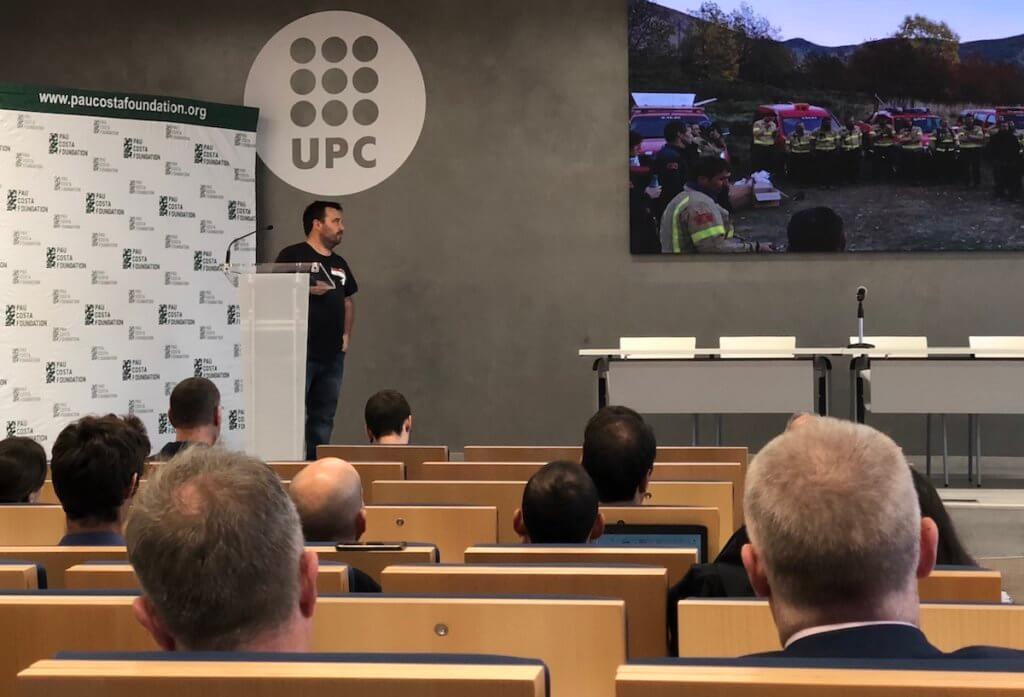
Sharing responsibility
Allocating wildland fire management and related responsibilities among various entities is a challenging and well-known bottleneck. Fire responders are being burdened with the bulk of this. Management of large wildfire emergencies today is not only defining the present landscape, but it is also shaping the near- and long-term fuel structures and hence determining future fire risk. Response-phase actions are not only involving flame suppression in the immediate term, but also shaping the future in terms of wildfire risk and impact on society. This is an important message that should be better communicated within the entire wildfire community.
Forthcoming scientific and technological advances are key to support current challenges in wildfire management. We need therm to provide the precise data and other knowledge to facilitate better informed decision-making processes not only in terms of fire response, but also in prevention, mitigation and recovery measures. Moreover, they are the underpinning that will reduce uncertainty and help help us move from experience-oriented to science-oriented decisions. The question arose if emergency managers would base their decisions more on science rather than experience, and if scientists and technology providers would be willing to take more responsibility for engaging managers? Opinions during the Forum were diverse. Some said research is ready to embrace responsibility in the short term, while some argued that science is not yet prepared to take responsibility for landscape and fire management actions, at least not with the current level of scientific understanding under rapidly shifting global changes.
It was agreed that better communication between managers, researchers and policy makers is needed to allow them to understand each other’s viewpoints, have more productive debate, and find common ground in order to reach consensus and obtain political and social commitment for these shared responsibilities.
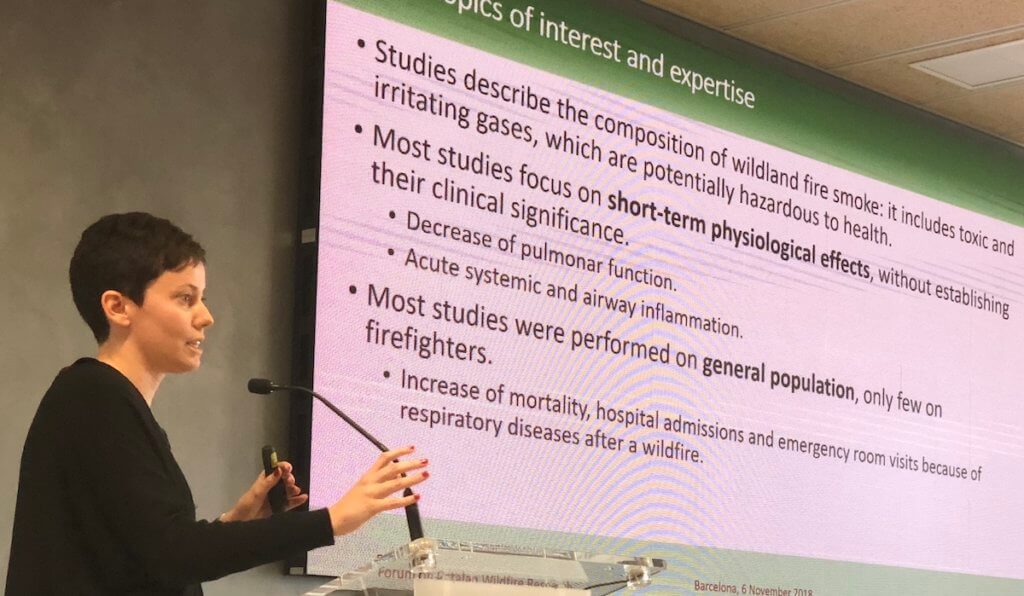
Collaboration opportunities
To ensure fair, efficient and effective applicability of research and technology, the outcomes and products require better coordination and understanding between the different groups. Shared goals and strategies will encourage the development of novel, transdisciplinary research, integration of end-users with early stages of research development.
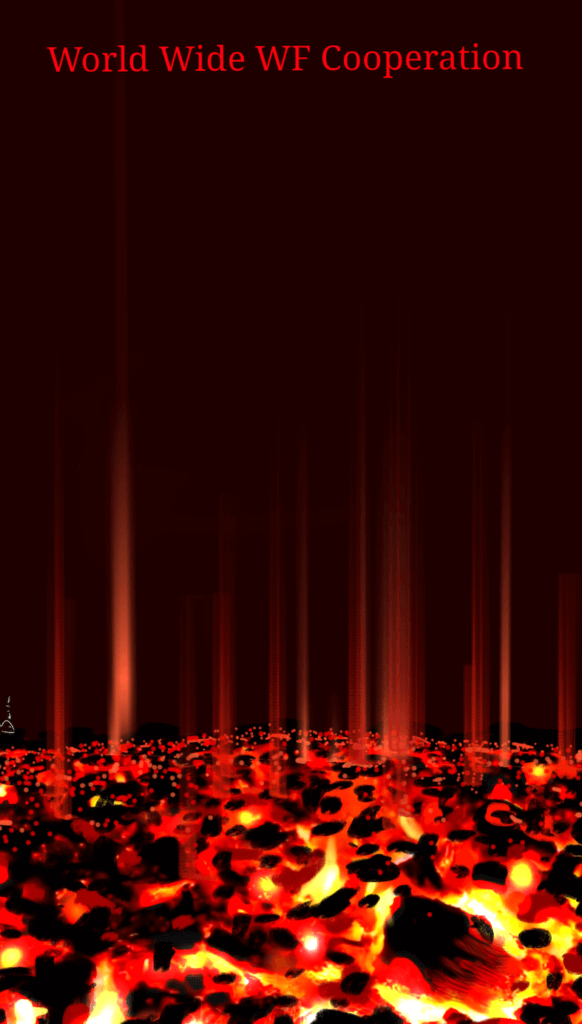
Of the strategic actions identified during the Forum, these five strategies are key:
- Integrate social scientists in transdisciplinary teams
Teams that integrate social scientists, journalists and educators are needed to effectively transform technical results into communication outputs that connect with society. Transdisciplinary collaboration is needed to improve scientific and technical communication.
Thanks to technological evolution, there is a broad range of communication channels and digital technologies available to achieve our goals (web broadcasting, social media, augmented reality, etc.). However, using the right channels is not enough; appropriate and meaningful messages have to be composed and delivered to the entire community. The key to mitigating impacts of this new generation of wildfires is communication with society in laymen’s terms.
“Despite the consensus from the fire management and research communities that prevention is needed, prevention is not sexy. It never hits the news.” – P. Navascués, Forest Fire Prevention Bureau, Diputació de Barcelona.
- Develop a stronger global network to support regional challenges
Business-as-usual prevention, preparedness and response are insufficient to deal with current and emerging wildfires. Efficient knowledge-sharing between regions with similar challenges will amplify the ground-truthing of lessons learned as unprecedented wildfires burn amid changing societies, climates, ecosystems and fire behavior.
Enhanced collaboration between experts around the world is key to improving the knowledge on fire and enhancing landscape resilience. In each wildfire, prescribed burn or regional fuel treatment initiative, there are unique and valuable experiences, best practices and lessons learned to be collected and shared. This knowledge can inform and guide us in dealing with future threats and solutions in other regions, and to understanding wildfires globally. Local and regional initiatives relying on the collaboration of scientists, managers and local actors are finding ways to successfully implement integrative fire management and create circular economies [3]. Finding ways to globally share local success stories is essential.
Participation on collaborative projects is one way to effectively foster this knowledge-sharing between research and management communities. It has happened so far in some projects even if this was not their direct purpose. However, initiatives that specifically aim at knowledge exchange are needed. Some initiatives and institutions identified in the Forum that serve this purpose include the International Association of Wildland Fire[4], the LANDFIRE program [5 ]in the US, the Bushfire and Natural Hazards CRC [6] in Australia and the Pau Costa Foundation [7] in Europe.
- Create collaborative databases
From a research perspective, data collection is often one of the most time and resource consuming tasks. Consequently, it may take years to validate some research outputs that practitioners currently need to prevent and manage current wildfires. Extreme wildfire behavior data is probably the best example. In general, this makes research outputs of very limited utility in the short-term and weakens the relationship between management and science.
Collaboration in the wildland fire community would provide vital, high-quality, standardized data. Managers on the ground are willing to exchange empirical knowledge generated during their years of experience and also help collect data at wildfires or prescribed burns. These partnerships require tight connections between fire managers and researchers so that the former can better understand the scientific approaches to data collection that will later be analyzed to shape policy and approaches.
Having a common database of international fire data providing continuous records in time and space would greatly facilitate the work of researchers and developers around the world.
- Enable industry alliances
Industry can play a fundamental strategic and tactical role in improving management-science collaborations. Support from private sector technological partners is beneficial for the development of sound and applicable research. Subject matter experts can have an important intermediate role but often they are not part of the discussion. New technologies, such as artificial intelligence (AI) in the field of wildfire management, represent a great advancement in decision making. Yet incorporation of AI will not happen without strong collaboration between researchers, industry and practitioners.
FIRE-IN [8] is a 5-year European-scaled initiative that is identifying issues and prioritizing linked research and industry opportunities with clear benefits for wildland fire management.
- Define strategic agendas
Ultimately, public administration must take decisive and specific action. Policy-makers are rarely present at conferences and other knowledge-sharing events where current and emerging matters are discussed; nor are they allocating funds and other resources to address knowledge exchange needs.
An Open Letter to the European Commission [9] after the 2017 wildland fire events in Europe called for action from various public administrations. We need much more involvement at all levels of government — local, regional, national and international. It is clear that much more involvement at all levels of government — local, regional, national and international — is needed. By working together, researchers, industry and managers can reach policy makers and society with the stronger voice urgently needed to face current and future wildfire threats.
RESOURCES
Archive of live tweets: #WildfireForumCAT
All presentations, videos and information of participant research groups of the Forum are available in the Lessons on Fire Platform: https://lessonsonfire.eu/en/community/forum-catalan-wildfire-research
+
[1] Copernicus, EFFIS data: http://effis.jrc.ec.europa.eu/static/effis_current_situation/public/index.html
[2] M. Castellnou, Forum on Catalan Wildfire Research, vídeo playlist: https://lessonsonfire.eu/en/document/video-playlist-forum-catalan-wildfire-research
[3] https://www.ramatsdefoc.org/ca/
[4] https://www.iawfonline.org/
[6] https://www.bnhcrc.com.au/
[7] https://paucostafoundation.org/
[9] http://www.paucostafoundation.org/ing/open-letter.php
